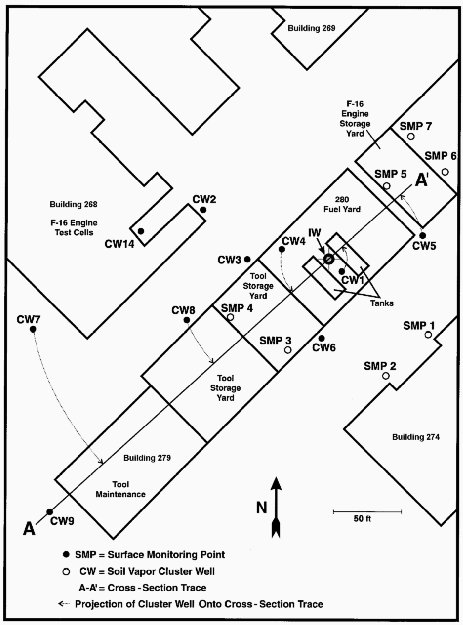| |
Bioremediation Field
|
United States Environmental Protection Agency
Office of Research and Development, Washington, DC 20460
Office of Solid Waste and Emergency Response, Washington, DC 20460
EPA/540/F-95/506C September 1995
| |
Bioremediation Field
|
Location: Salt Lake City, Utah
Laboratories/Agencies: U.S. Air Force, U.S. EPA National Risk Management
Research Laboratory (NRMRL), U.S. EPA Region 8
Media and Contaminants: JP-4 jet fuel in unsaturated soil
Treatment: Bioventing
Date of Initiative Selection: Spring 1991
Objective: To evaluate the effectiveness of bioventing jet fuel in deep
vadose zone soil
Bioremediation Field Initiative Contact: Gregory Sayles, U.S. EPA NRMRL,
26 West Martin Luther King Drive, Cincinnati, OH 45268
Regional Contact: Robert Stites, U.S. EPA Region 8, 999 18th Street,
Denver, CO 80202-2466
In 1988, the U.S. Air Force initiated a study at Hill Air Force Base (AFB) to examine the potential of bioventing to remediate JP-4 jet fuel-contaminated soils. Bioventing is the process of supplying oxygen in situ to oxygen-deprived soil microbes by forcing air through contaminated soil at low airflow rates. Because bioventing equipment is relatively noninvasive, this technology is especially valuable for treating contaminated soils at military bases, industrial complexes, and gas stations, where structures and utilities cannot be disturbed. Promising results from the Air Force’s initial study prompted the U.S. EPA National Risk Management Research Laboratory (NRMRL) and the Air Force to conduct a field evaluation of bioventing at Hill AFB and at Eielson AFB (see separate fact sheet, EPA/540/F-95/506B). The main objective of the Hill AFB evaluation was to determine the effect of air injection flow rate on the effectiveness of bioventing in stimulating biodegradation while minimizing volatilization. The evaluation also provided an opportunity to gain experience in bioventing large volumes of soil with plumes of fuel that extend deep beneath the surface as well as under roads, underground utilities, and buildings.
Prior to bioventing, the Hill AFB site was contaminated with JP-4 jet fuel from a depth of about 35 ft to the ground water 95 ft below the surface. The contaminated soil was a mixture of sand, silty sand, and sand interspersed with gravel and clay. Soil samples taken in September 1991 revealed an average total petroleum hydrocarbon (TPH) level of 890 mg/kg, with TPH levels at some depths reaching 5,000 mg/kg. At most depths, benzene, toluene, ethylbenzene, and xylene (BTEX) levels ranged between about 300 mg/kg and about 800 mg/kg. The area of contamination extended beneath a tool maintenance building, engine storage yard, and fuel storage yard (see Figure 1).

Figure 1. Plan view of Hill AFB site.
Unlike soil venting or soil vacuum extraction, bioventing uses low airflow
rates to stimulate biodegradation while minimizing volatilization of
contaminants in soil. Higher airflow rates stimulate faster and more widespread
biodegradation but also release more volatile emissions to the surface. To
study the tradeoff between the rate and range of biodegradation and the release
of volatile emissions, the Air Force and NRMRL operated a bioventing system at
the Hill AFB site from July 1991 to January 1995, changing the airflow rate
about twice a year. They conducted a total of five airflow rate evaluations:
one each at 28, 67, 67, 40, and 117 ft³/min. The 67-ft³/min
evaluation was repeated to include additional monitoring points added to the
site. Each airflow rate evaluation included:
The Air Force and NRMRL have collected and analyzed bioventing performance data for each of the four airflow rates. The total rate of biodegradation increased with increasing airflow rates, because the radius of biological activity increased. Surface emissions rates remained about the same with increasing airflow rates. Moreover, surface emissions rates during air injection were not significantly different from those during bioventing shutdowns. This was an important finding because it indicates that bioventing at the airflow rates evaluated (28 to 117 ft³/min) does not increase emissions of volatilized contaminants.
Final soil sampling conducted in December 1994 revealed that TPH and BTEX levels had declined at all but one soil depth within a 25-ft radius of the injection well. Only at a depth of 90 to 100 ft (at the capillary fringe) did TPH and BTEX levels fail to decline, suggesting that the capillary fringe was not adequately aerated. These results help demonstrate the feasibility and effectiveness of bioventing at the airflow rates evaluated.
| The Bioremediation Field Initiative was established in 1990 to expand the nation’s field experience in bioremediation technologies. The Initiative’s objectives are to more fully document the performance of full-scale applications of bioremediation; provide technical assistance to regional and state site managers; and provide information on treatability studies, design, and operation of bioremediation projects. The Initiative currently is performing field evaluations of bioremediation at eight other hazardous waste sites: Libby Ground Water Superfund site, Libby, MT; Park City Pipeline, Park City, KS; Bendix Corporation/Allied Automotive Superfund site, St. Joseph, MI; West KL Avenue Landfill Superfund site, Kalamazoo, MI; Eielson Air Force Base Superfund site, Fairbanks, AK; Hill Air Force Base Superfund site, Salt Lake City, UT; Reilly Tar and Chemical Corporation Superfund site, St. Louis Park, MN; and Public Service Company, Denver, CO. To obtain profiles on these additional sites or to be added to the Initiative’s mailing list, call 513-569-7562. For further information on the Bioremediation Field Initiative, contact Fran Kremer, Coordinator, Bioremediation Field Initiative, U.S. EPA, Office of Research and Development, 26 West Martin Luther King Drive, Cincinnati, OH 45268; or Michael Forlini, U.S. EPA, Technology Innovation Office, Office of Solid Waste and Emergency Response, 401 M Street, SW., Washington, DC 20460. |